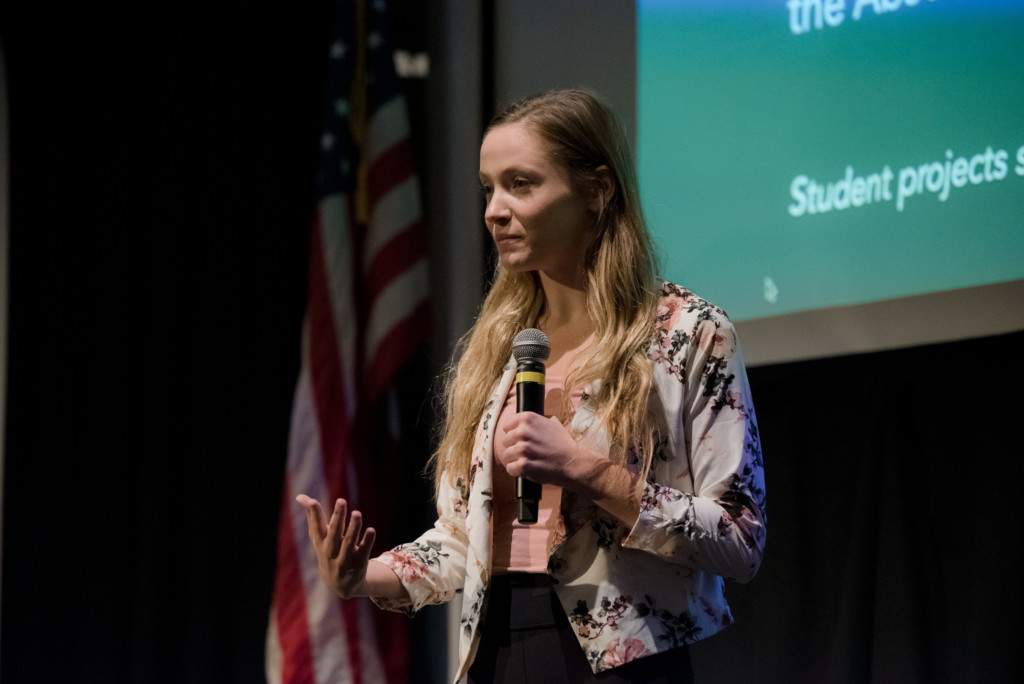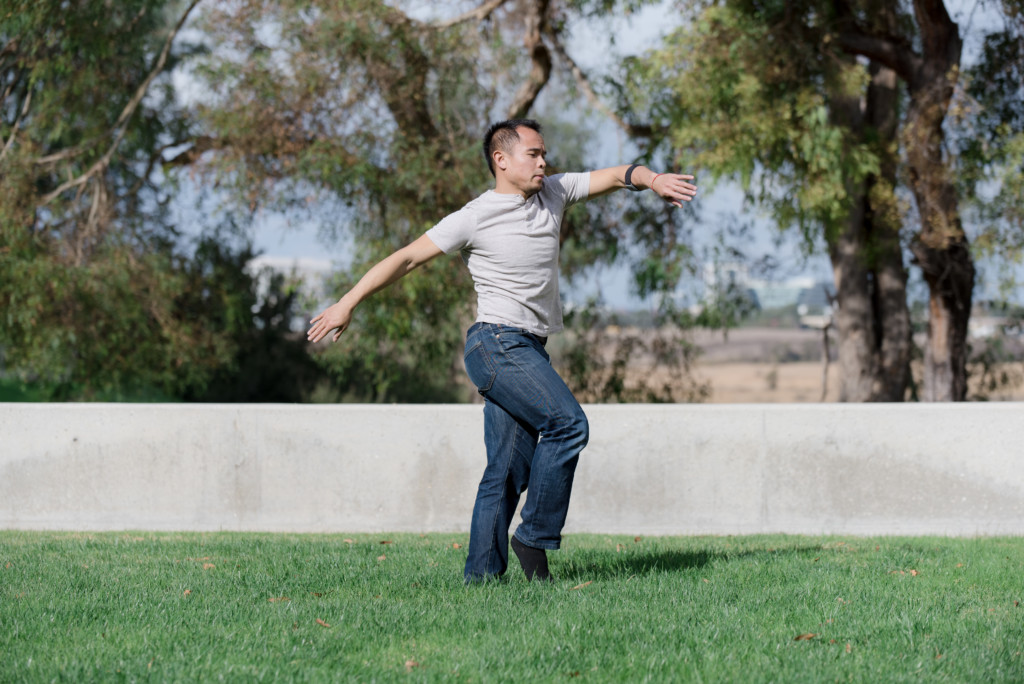The Artistic Brain & Immersion
Have you heard the one about the artists and the scientists?
Two dancers, two musicians, an actor and a painter walk into a science lab.
A musician tells the scientist he would like to know whether his music is able to change his audience’s thoughts and feelings. A dancer says she’d like to figure out how her brain is changing while she’s dancing. The painter says she would like to know what’s happening in her brain while she’s painting and how the brains of her viewers react when they see the artwork. The actor says she would like to find way to use her brain more efficiently in rehearsals.
If you are looking for a punchline, there isn’t one. Because this actually happened.
UCI Brain is an academic initiative that fosters interdisciplinary interactions about our understanding of the brain. During the UCI Brain launch event in November 2019, the Claire Trevor School of the Arts participated in a demonstration to help illuminate one of the initiative’s cross-cutting themes centered on the arts entitled, The Artistic Brain.
Before I tell you how The Artistic Brain empowered students with technology to measure brain activity while performing, let me give you a brief history.
In the Fall of 2017, the UCI Drama department offered a Science of Acting class. World-class brain scientists sat with actors and discussed thoughts, emotions, language, and the influence of memory on behavior. The actors found the scientific perspective empowering and even “life-altering.”
In the Fall of 2018 UCI brain scientists and Hollywood creatives collaborated on hosting a public event, Why Our Brains Love Story. The event was co-sponsored by UCI Illuminations, the Chancellor’s Arts and Culture Initiative. Based on the techniques learned, the audience brainstormed a story situation to generate a framework for a one-act play. A drama student was then coached over a couple of months using a brain-based approach to story creation resulting in the first-ever one act play of its kind. The play, titled “Soles” will be performed in the spring of 2020.
During the summer of 2019, renowned neuroeconomist Paul Zak entered the collaboration and generously granted UCI the use of his neuro-immersion platform. This technology uses a wearable sensor that infers the brain’s attentional and emotional responses from the peripheral nerves. Zak’s team call the neural state in which one is attentive and emotionally absorbed in the experience, “immersion.” Immersion values fluctuate between 1 and 10 and change, with the level of immersion giving us insight into how valuable the experience is to the brain. While the commercial uses are numerous, the technology provides Arts students the rare opportunity to measure an audience’s, as well as their own physiological response to a performance or while rehearsing an art form.
In the Fall of 2019, six UCI Arts students signed up for an independent study that would incorporate the neuro-immersion technology in a weekly lab. The artists were instructed on simple models of brain function and given direct access to brain scientists to answer their questions. Each student was tasked to choose an aspect of their craft to explore and measure. They would present the results of their exploration at the launch event for UCI Brain and The Artistic Brain theme.
So, … two dancers, two musicians, an actor, and a visual artist walked into a science lab. What did they learn?
Here are the explorations the students designed and presented to a rapt audience during the UCI Brain Launch event on Nov. 21, 2019.

The Visual Artist
Alex Miranda chose to explore whether her own immersion levels during the creative process might correlate with the viewer’s experience of the art. She painted two very similar paintings while measuring her own immersion level. She then invited three groups of her peers to view each painting for ninety seconds, while capturing their unconscious responses to each work.
She discovered she was only slightly more immersed during the creation of the second piece. However, all three groups showed an immersion preference for the first piece. This experiment caused her to contemplate the slight differences in the artwork. She now believes that a variation in the texture in these works likely resulted in the viewer’s preference. She plans to use this newfound knowledge of texture in future works.

Dancer
Katie Pierce compares the difference between her own immersion levels in a choreographed dance without music versus an improvised dance to music. She believed her immersion levels would be higher in improvised dance, and much to her surprise, she was mistaken. Rethinking her approach, she came to recognize that predetermined choreography allowed her brain to focus on the performance of those movements in a way that increased the brain’s enjoyment of the work. Her new goal is to raise her immersion levels during improvisational dance. She plans to experiment with different ways of rehearsing her improvisational techniques while using the neuro-immersion platform for immediate feedback during future experimentation.

Actor
Pallavi Rajan explored ways for actors to get the most out of their time spent in rehearsal. Her goal was to explore different rehearsal methods and observe the effect each had on the actor’s immersion levels and psychological safety. Psychological safety is a measurement that represents comfort level during an experience. Feeling safe during the rehearsal process is believed to impact the actor’s ability to create.
She invited two actors to develop two different monologues. During the first session both actors spent 15 minutes preparing the monologue by repetitive rehearsal. Then she captured their physiological responses using the neuro-immersion sensors, while they performed.
The preparation of the second monologue involved three specific activities: mapping the environment (guided imagery), improvised interviews and physical warmups, after which the actors performed their monologues while wearing the sensors.
While she found there was not a significant difference in the immersion levels in the first and second readings, she did find significant differences in psychological safety during the exercises as opposed to the performances. This raises a number of questions and possibilities for future work.

Musician
Agust Manzanares describes his experience as “surprisingly fun.” He signed up for the class expecting people to do experiments on him and considered dropping the class when he discovered he was going to be the experimenter. After coming to terms with his unexpected role and being introduced to the technology, he became curious about how immersion levels might correspond to the complexity of music. He invited two groups, musicians and non-musicians into the studio and played two pieces live; one very simple tune and the other more complex. He found that in both groups, the simpler music garnered higher immersion levels.
He is further interested in seeing if there might be a specific immersion response for the ‘jazz lick,’ a spontaneously occurring musical phrase that consistently appears in jazz music. Agust really enjoyed his experiment and claims that it “made him see the scientific world differently.”

Dancer
Leandro Damasco has developed a new movement language that he called Ebb and Floorwork, which seeks to stimulate a ‘flow’ experience for dancers . Flow is a well-documented mental state made famous by Hungarian-American psychologist Mihaly Csikszentmihalyi “in which people are so involved in an activity that nothing else seems to matter.” Leandro sought to examine the various levels of immersion that resulted from specific movements in his new framework.
He and one of his less experienced students performed a particular sequence of Ebb and Floorwork movements while wearing neuro-immersion sensors. He expected the student’s immersion levels to be higher than his own, hypothesizing that the less experienced dancer would expend more effort, which would increase immersion. However, instead he found that he had higher immersion levels overall, leading him to reconsider the value of memorizing the movements verses the experience of performing each specific movement. Ultimately, he was able to identify specific movements that peaked immersion. He plans to create choreography in the future by stringing together movements that result in high immersion and matching those high-immersion sequences to emotional peaks or swells in the music.

Musician
Adib Ghorbani sought to explore how immersion levels of the audience vary in two different music performance settings. He explored
specific differences between a passive audience versus an actively participating audience.
Live at the UCI Brain launch event, several audience members volunteered to wear sensors, with their responses publicly projected on a big screen for all to see during his performance. He played one piano piece while the audience simply listened. In his second piece, he began to interact with the audience.
As predicted, the audience’s immersion levels were higher when they were asked to interact with the music. However, their level of psychological safety was lower when asked to participate as they were being instructed to do something new they were not expecting to learn.
Although he appeared to be speaking to the audience off the cuff, he had scripted his interactions with the audience as part of his musical score. Afterwards he was able to match the audience results to the specific moments in the score, which helped him better understand how the mix of theatrical and musical interactions affects the audience. He plans to continue to explore audience response in the future by assigning different roles to the audience while measuring immersion responses in each role.
The entire project was a tremendous success. It clearly demonstrated the transformation that is possible when arts educators step out of their comfort zone and implement new technology into the curriculum. The event was also successful in fostering interdisciplinary collaborations across all facets of the campus and brought the sciences and the arts together for the first time.
Arguably, however, the project’s greatest achievement was that this short independent study had a massive impact on the students.
All six students reported high enjoyment levels and were inspired to embrace a new perspective on their craft. A musician rescinded his previous distaste for science. A visual artist developed a premise for her own distinct creative style. A drama student now seeks to improve century-old theatre practices. And a dancer has declared psychology as a minor!
Minds expanded, creative abilities enhanced, and brains are forever altered.
A brain-based perspective for artists is extremely rare. Most artists are not aware they can achieve such directly measurable results. Yet when presented the opportunity and given the tools, artists enthusiastically embrace a new way of thinking. Measuring results develops new perspectives, and an interdisciplinary approach can significantly accelerate the student’s learning curve for both intellectual and artistic growth.
The possibilities for the integration of a scientific approach within arts education and practice are vast. Share your ideas for using this technology with the arts on our social media pages.
Watch the Artistic Brain Demo during the UCI Brain Launch Event.

David Ihrig
David is an actor, teacher, and acting coach. He is part of the UCI Brain initiative team and is helping to shape the Artistic Brain theme at UCI. He designed the university’s first interdisciplinary course on the ‘Science of Acting.’ David is developing innovative concepts for ‘The Actor’s Laboratory’ to better bridge the art of acting with the science of the brain. He is currently advancing the use of predictive technology with brain-based writing methodologies towards the generation of best practices in story development.
